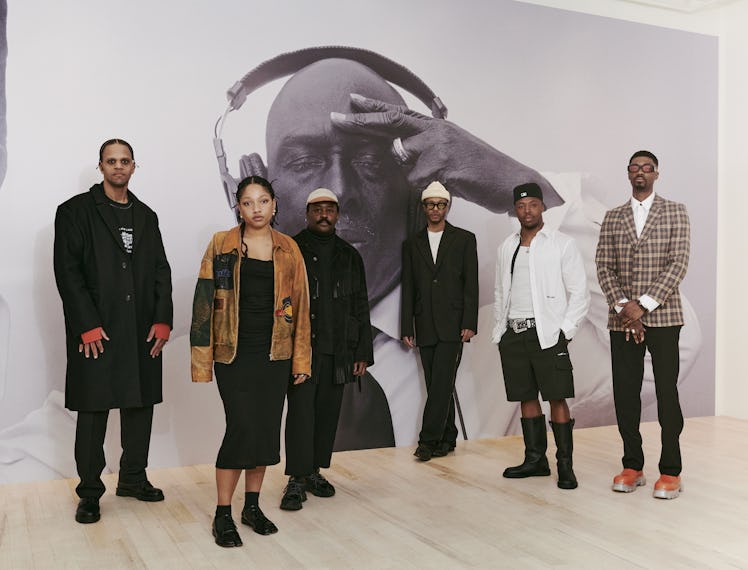Antwaun Sargent & Helmut Lang Reconsider the Cowboy
For an exhibition at the Hannah Traore Gallery, Sargent tapped a group of artists to share their visions of the American West.

While the cowboy aesthetic is well-worn territory in art and fashion, a collaboration between Helmut Lang and Antwaun Sargent, a director and curator at Gagosian, explores the concept to break new ground. The brand’s famous reverse cowboy T-shirt, first released in 2004, nods to none of the classic elements of cowboy fashion—the blue jeans and leather boots that remain staples of America's sartorial identity—favoring a spare design that makes a bold statement, one that asks viewers and wearers of the garment to imagine the possibilities implied by that label.
The shirt functions as the point of departure for the brand’s AW 2023 collection as well as for the complementary art installation, for which seven artists chosen by Sargent (Turiya Adkins, American Artist, Awol Erizku, Devin B. Johnson, Justen Leroy, Daniel Obasi, Quay Quinn Wolf) were tasked with plumbing centuries of history and mythmaking around the cowboy and western aesthetic. Titled “Helmut Lang Seen By Antwaun Sargent,” the show is on view at the Hannah Traore Gallery on the Lower East Side through February 23. Though it finds its basis in the traditional iconography of cowboy lore, Sargent’s lens spans from Lagos to Los Angeles, beyond the badlands and the 1800s through to the present day.
“From a contemporary standpoint, this notion of ‘cowboy’ has really taken on global dimensions in our culture,” Sargent tells me, as the artists take in their first looks at the installed pieces. There are hours between our chat and the show’s debut, but already a buzzy energy within the gallery lures a few passersby inside, only to be turned away until the official opening. “I thought about everything from Beyoncé’s Renaissance album cover to [featured artist] Daniel [Obasi]’s images of cowboy culture in Africa, in New York, in Philadelphia, in the American South and West. So it really wasn't about the American West, it was about new narratives and the way that notion has taken on [meanings] that are not necessarily always connected to the realities of what it meant to be a cowboy in the eighteenth and nineteenth centuries. The exhibition is a way to rethink, reimagine or further imagine the different components of this grand narrative.”
A gallery view of Helmut Lang Seen by Antwaun Sargent, “YOBWOC” at Hannah Traore Gallery
With the T-shirt as their anchor, the artists ventured off in all different directions examining themes of spirituality, masculinity, and migration for their works. The resulting exhibit is a mix of paintings, photographs, sculptures, and sonic components. Justen Leroy’s submission, Hymn 1, mixes media: the black and white image of a man with two fingers pressed against his forehead and two pointed skyward covers the gallery’s entire back wall as a prayer rings out through headphones. The subject is Leroy’s father, eyes closed and clearly channeling something greater, the opposite of lost in thought. Breaking out into song or prayer is a common occurrence for the artist’s dad, one Leroy wanted to capture for his submission and layer atop the visual element. “I was thinking about the show and cowboys and really [my father’s] journey from Kingston, Jamaica, to the Americas and the spirituality of that journey,” Leroy says. “What is in the spirit of the cowboy on that journey? While you’re being nomadic, what are you praying for, praying about? What kind of song are you singing to yourself when you’re in the heat of the desert sun? [I was] trying to get into the heart and the mind and spirit of the cowboy.”
In contemplating the cowboy’s journey, artist Quay Quinn Wolf thinks of grime and buildup, strain on the body, the patina on a saddle. The sculptor experimented with rubbing essential oils on leather to the point of bruising and tearing for submissions Bruise No.1 and Bruise No.2. The pair are installed directly behind Saddle, also Wolf’s work.
“When you think ‘cowboy,’ you think masculinity,” Wolf says. “I was looking for an auto body repair stand that looks a lot like a saddle rest [for Saddle]. I’ve used auto body repair stands in the past to talk to societal notions of masculinity. I often pair them with drapey things or clothing that’s embroidered with pearls so there’s a bit of tension between what society considers masculine and feminine. I hand cut lamb leather and wove it since I also wanted to talk about community, and that kinship of cowboys, like the weaving together of a quilt.”
The exhibit’s pieces are all in dialogue with the Helmut Lang T-shirt, so it’s only fitting that the concept behind the show inspired some designs for a few accompanying garments. Limited edition T-shirts featuring pieces displayed in the exhibit, as well as a shirt depicting Sargent’s own take on the COWBOY T-shirt, (which swaps the backwards label “COWBOY” for “ART”), are available for sale. “It really is a way not only for the artists to create new commissioned works but also to create our own garments within the discourse that we had around creating this exhibition,” Sargent says.
For Hannah Traore, the show is a major marker of success after the one-year anniversary of her gallery’s opening, and one that aligns perfectly with its mission. “If you told me a year ago that someone I respected as deeply as Antwaun Sargent would be curating an exhibition that would be on the walls of my gallery, I simply wouldn’t believe you,” Traore gushes. “And it goes so well with the ethos of my gallery: this group of amazing Black artists, all different mediums, really pushing the envelope, all brought together by Antwaun. It’s kind of a ‘pinch me’ moment.”